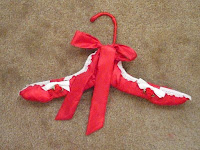Many years ago, when we would visit my grandmother in the winter, she usually had a wool braided rug 'up and going'. She related to me that when she and grandpa got their piece of homesteading land in northern Wisconsin, there was plenty to do outside in the summer. But in the winter, after the animal 'chores' and the 'house duties', one had to find something to do to pass the time (and I assume to keep one's mind off the fact that one was living in a drafty and cold one room log cabin with two little girls). Grandma, like many other homesteading housewifes, spent much of her time creating 'niceties' like braided rugs for their modest homes. . Not only were they a great improvement over the 'feed sacks' that were nailed to the rough floor in the log cabin, but creating them made the time go faster, made a rough looking log cabin homey and warm, were a frugal way to extend the life of wool items that were no longer useable as clothing, etc. and were enjoyable to create. Grandma' rugs were made of wool strips 2" wide. She would save every scrap of wool from worn out garments, blankets, and sometimes wool that was given to her. Then in the winter she would 'braid'. The first winter she had enough wool for a rug approximately 4' across. So, she would then tuck the raw braided end under the rug for the spring, summer and fall, and in the winter untuck the unfinished braid end and once again begin adding onto the rug. After several winters, the wonderful hand braided rug became an incredible 13' across. When they moved from the one room log cabin to a 'real stick built house' on the farm in northern Wisconsin, grandma's wonderful wool rug moved from the log cabin to the house. It was STILL in use when I was a child. Every winter before Christmas, the men would roll up the rug, carry it outside, unroll it in the snow and grandma would 'snow clean' the rug. Then it was brought back into the house for the Holiday Season all fresh smelling and dust free until the next winter when the procedure would be repeated.
When my grandfather died, grandma moved in with our family and lived with us off and on until she passed away. She taught me so very many skills, crafts, and needlework disciplines that are fast becoming obsolete and unheard of. As a child, I 'helped' her cut wool for some throw rugs she made for us. I still have the rugs, and they hardly show any wear. They are over 60 years old and had much use.
Several years ago I decided I would like to keep the craft of hand braiding rugs alive by creating one myself. A friend of mine and I began our journey into rug braiding. We started by visiting 'Thrift Stores' within a 100 mile radius on the days when they had their 'quarter' sale days. The result was a plethora of coats, jackets, skirts, and blankets of 100% wool. All items were completely disassembled and all unuseable parts were discarded. Then all the pieces were washed in the washing machine using HOT water, and dried in the drier on HOT. I then lightly pressed all the pieces with a steam iron to remove any wrinkles. Then all pieces were cut in 2" strips and rolled into 'rug rolls'.

I then began my braided rug. I did purchase a book from Amazon "The Braided Rug Book" by Norma M. and Elizabeth J. Sturges. It was a VERY WISE purchase, and the instructions are just as my grandmother had done for years. I am glad to have the book as a reference for all aspects of rug braiding.
My rug is an oval rug, and began like this:
It is progressing, and is now approximately 4' x 2-1/2'. I saved all of the labels from all of the garments used in the rugs (even one "Harris Tweed" jacket from Scotland--hand woven wool). When the rug is finished (hopefully this winter), I will have all of the labels, each with its own swatch of fabric from 'whence it came' attached. Then I will mount them on matt board with a small provenance statement and keep it with the rug for posterity.
After braiding, the rug is 'laced' (NOT SEWN) together with linen cord. The lacing allows the rug to be reversible and hence extends the wear of the rug. The braid itself is approximately 1-1/4" and is about 5/8" thick. That means there is 5/8" of warm, solid wool under your bare feet. Not many carpets can compare with that durability and warmth. I need to get back to braiding. That will all come in good time, but first I must get 'The Thornhill' built. I will probably do some braided rugs for the doll house too. Except that they will be braided with fine wool yarn and not wool fabric to meet the 1:12 scale of the house.
That is my entry for today. Hope it sparked some interest in someone in the traditional and increasingly 'lost art' of rug braiding.
Dottye






































